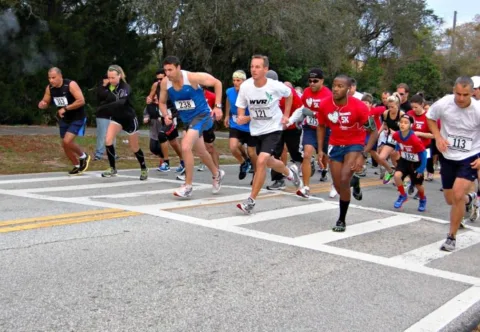A half marathon is 13.1 miles. Training is required in order to boost your endurance and strength — especially if you’ve never run that distance before.
Your training schedule for a half marathon should start at least 12 weeks before the actual event — so your body can become accustomed to the distance. (If 12 weeks doesn’t sound like enough time, then begin training 13 or 16 weeks before the half marathon.)
The training plan for a half marathon varies by runner — based on your personal experience as a runner and your fitness level.
Here’s how to go from the couch to a half marathon in 6 months.
Before You Start Training…
A half marathon is not an easy race to run. Putting together a comprehensive half marathon training program is a must — whether you’re a beginner, intermediate, or expert runner.
If you are 35 years old or older, you should consult with your doctor first and have a thorough physical exam before starting your half marathon training program.
Begin by writing out your own half marathon training schedule after browsing several 12-, 14-, and 16- week plans. Make it a training plan that fits into your personal schedule and is not too difficult for your fitness level.
Be sure to allow 2 rest days a week, plus 1 day to cross train (more on that in a minute).
If you’re unsure how to make your own half marathon training schedule or want tips from professionals, you can download half marathon training programs from the Internet or use half marathon training apps.
A Sample Half Marathon Training Plan
Once your half marathon training plan has been written down (or downloaded), the actual training begins.
As a first-time half marathon runner, you’ll want to follow this general plan:
- Several short runs — 1 to 2 miles, 3 days a week. If you’re training with a heart rate monitor, stay in the 65 to 70% zone.
- A longer run — 3 to 4 miles, 1 day a week. The long run should fit into your training program on a day where time is not an issue. This is a long, slow distance run (also known as a ‘fat burning run’). You want to keep a pace that makes it easy to maintain a conversation.
- The 7th day on the half marathon training plan is used for cross training.
Here are 4 hurdles you will face in your half marathon training.
What Is Cross Training?
Cross training can be anything from bicycling, walking, swimming, rowing, or using an elliptical trainer.
Cross training is not a weight-bearing activity. You want to maintain and build on your aerobic fitness, while also giving your body a rest from the wear and tear of running. Source
Sports such as volleyball, soccer, and football are not recommended for cross training — because the side-to-side movements and sudden stops that are made in those sports make a runner more prone to injury.
The focus of cross training is to build muscle in areas that running alone will not.
Upper body strength is important for runners — because these muscles come into use when your legs become fatigued.
Adding a day of cross training in your half marathon training program will give your other muscle groups a chance to rest and rebuild — which is important for good health. This will also help you avoid injuries.
Add A 5K To Your Half Marathon Training Program
Expert runners will sometimes run in a 10k or 15k race as part of their half marathon training plan. These short races add variety to the training program and give them an idea of how their half marathon training is progressing.
Beginning runners may want to add a 5k to their half marathon training program. A short race like a 5k will help build your confidence. It can also shed light on any areas of weakness that may need to be focused on harder in your training.
Look at half marathon races at least 2 months from now. If you can run a 5K now, then you can run a half marathon in 8 weeks. But the ideal plan is 3 to 4 months long — which gives you a buffer if you get sick, injured, or slammed at work. Basically, plan for life to get in the way — as it so often does — so you don’t stress yourself out. Source
Slowly Increase Your Running Distances
The training program for a half marathon allows for a gradual increase in the number of miles run 4 days a week.
For example, as a beginner you’ll start with 1 or 2 miles 3 days a week and a longer 3- or 4-mile run 1 day a week. These miles should increase until the shorter runs reach 5 to 6 miles and the long runs reach up to 10 miles.
The goal of the half marathon training plan is to build endurance over a 12-week period — so you will know what to expect when running the actual 13.1 miles. A slow progression is the best way to prepare your body for the rigors of such a long distance.
Train For The Terrain
When most people picture a marathon or half marathon race, the Boston Marathon is what they see — thousands of people ready to run the city streets battling bad weather at times.
Not all half marathons are run on pavement — there are many races run in mountainous settings or on trails. If this is the terrain you are going to run in, then your half marathon training plan needs to include at least one run over similar ground.
Not only do you need endurance as a runner, but you may also need to train for high altitude environments.
For example, in Colorado there is a race from Telluride to Aspen over a mountain that reaches about 12,000 feet above sea level. Altitude sickness is a real possibility if you are not trained for the lack of oxygen at that altitude. The more often you are able to add high altitude runs to your training program, the less likely you are to suffer altitude sickness.
Other obstacles can impede your performance when running in nature as well. On the route there can be:
- rocks
- uprooted trees
- streams
- twigs
- and more
For the Platte River Half Marathon in Littleton Colorado, runners must start the race by running through a creek which is usually topped with a couple of inches of ice. You run through the same creek at the finish.
Stay Hydrated
During a half marathon, you’re given water every 2 miles.
When training for a half marathon, you should drink water before, during, and after each training run.
Sports drinks can be used — but water is always the best choice for proper hydration.
Drinking soda during your half marathon training period can cause excessive water retention. You should try to avoid carbonated drinks as much as possible while you’re in training.
Eat Right
As you build muscle, your appetite also increases.
Your caloric intake needs to increase in relation to your increase in activity — you will sometimes feel as though you cannot get enough to eat.
Your diet should include lots of leafy green vegetables, plus lots of grains and proteins that will help you feel full.
Eating a healthy and filling diet will give you the extra energy needed to continue as you increase the miles on your half marathon training program.
On the other hand, going hungry will cause your body to go into survival mode and attack muscle for protein. The best plan is to eat many small meals a day to keep your muscles (and your entire body) healthy while you’re in training.
Go The Distance
So far, running 13.1 miles has not been a part of your half marathon training plan.
In the running world, there are different opinions about this:
- Some say not to run the actual distance until the actual event. They think the farthest a runner should train is 10 miles, and the last 3.1 miles on race day will be easy.
- Other runners choose to run the entire distance at least one time toward the end of the training process. They say doing this allows their body to feel the entire marathon and become accustomed to the distance.
The opinions are about half and half, and all have had success with the choice they’ve made.
Whether your half marathon training program includes all of the miles or most of the miles is a personal choice left to you.
Tips For Running Your First Half Marathon
If you are a first time half marathoner, then your goal should simply be to finish the race — not win the race. Competitive running comes with time and experience.
Also, you’ll be happy to know that walking breaks are allowed if needed. (Trust me, everyone needs a walk break at some point!)
I wish you the best of luck with your half marathon training program. As long as you stick with the training, you’ll succeed at the race.
Here are 4 keys to success for your first half marathon!
I enjoy running — especially in half-marathons!









